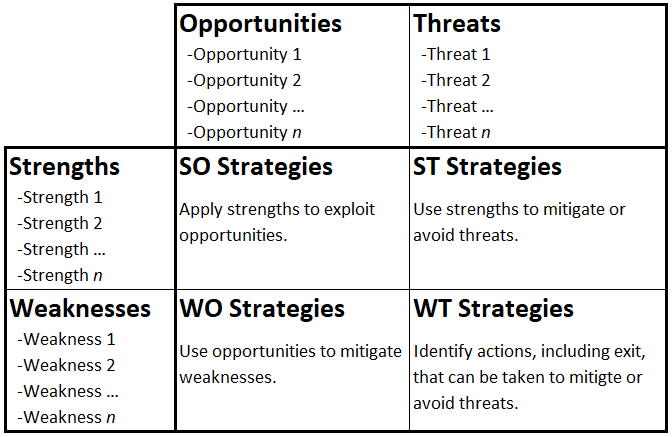
SWOT is an acronym for Strengths, Weaknesses, Opportunities, and Threats. The basic idea of this analysis is straightforward, but the decisions and actions can be as complex as can be imagined.
Much like the Important vs. Urgent grid, this technique involves identifying items in two opposing pairs, and then analyzing them in a grid as shown. It is generally performed to assess the state of an organizations readiness from multiple points of view. It may be thought of as an organized way of taking stock and preparing for the future. It may be applied to any time scale and across part of all of an organization, ranging from individuals to projects to departments to divisions to the entire organization.
Strengths are things an entity or capability does well and tends to support successful outcomes. They are contrasted with weaknesses, which are things an entity does less than well or does not do at all.
Opportunities are elements in the eternal environment that may be exploited for gain or success. These may include new technologies, mistakes by competitors, general economic tailwinds, and other factors. Threats, by contrast, are factor that pose challenges to the organization. They may include new strengths realized by competitors, new technologies, general economic headwinds, regulatory changes, and so on.
Care should be taken to ensure the analysis is thorough on the one hand, but targeted to the situation of concern on the other. Additionally, some elements will be obvious, especially with respect to opportunities and threats, while others may be more subtle or diffuse. Brainstorming lists of strengths and weaknesses can be a useful approach but again, make sure they are applicable.
Upon performing an analysis in any quadrant, the organization or entity can make plans to develop new technologies, advance proposals, team with other entities, purchase supplies, set aside extra finds, purchase or modify insurance, enter or exit markets, modify dividends, offer or repurchase equity or bonds, open or close locations, acquire other organizations or sell out to others, and so on. The possibilities are endless.
One unexpected form I’ve seen this take is a capability analysis performed by one of my former employers. They surveyed all the employees to list the skills they had and the types of analyses they could do, and the senior managers tried to identify opportunities they could go after by leveraging those capabilities. In the parlance of a SWOT analysis, this was an example of an SO strategy.
